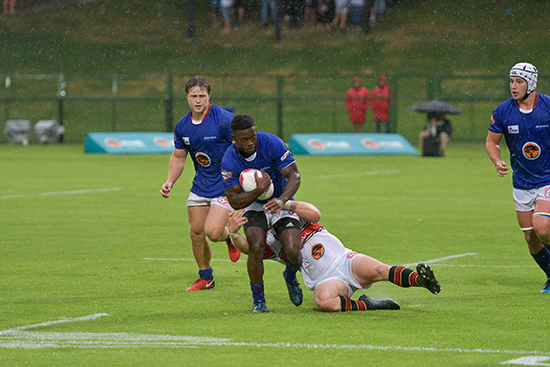Latest News Archive
Please select Category, Year, and then Month to display items
31 January 2018
Photo FNB Varsity Cup
 Lubabalo Dobela, Shimlas flyhalf (with the ball), played a key role in the Shimlas’ win over Tuks in the first round of the 2018 Varsity Cup.
Lubabalo Dobela, Shimlas flyhalf (with the ball), played a key role in the Shimlas’ win over Tuks in the first round of the 2018 Varsity Cup.
The Shimlas made a huge statement in their opening match of the 2018 Varsity Cup when they defeated last year’s champions at the Tuks Rugby Stadium in Pretoria.
The Free State students won the encounter against Tuks by 19-17 on Monday.
Tuks, who beat Shimlas twice last year, first in the group stage by 65-19, and then by 28-21 in the semifinals, were regarded as the hot favourites. The match was played in wet conditions which many thought would suit the home team better.
Determination carries team to win
But a young and inexperienced Shimlas team with 11 players making their debut in the competition proved that big hearts and guts count for just as much. It was only their third win in Pretoria in the 11th year of the competition and their second victory over Tuks since 2012.
As expected, both teams tightened up their approach. Shimlas struck back from a 0-5 deficit soon after the first strategy break as big and speedy wing Francois Agenbag stormed down the touchline to score a seven-point try. Flyhalf Lubabalo Dobela was on hand to convert and hand his team a 9-5 lead at the break.
Flyhalf stars in debut
The Shimlas extended their lead within five minutes of the restart as flank Benji Janse van Vuuren crashed over in the corner for a converted try. Dobela, one of the debutants who was named Player that Rocks (Player of the Match), controlled the match like a seasoned veteran. Apart from two difficult conversions from the touchline, he also slotted a penalty goal.
Researcher works on finding practical solutions to plant diseases for farmers
2017-10-03

Lisa Ann Rothman, researcher in the Department of
Plant Sciences.
Photo: Supplied
Plant disease epidemics have wreaked havoc for many centuries. Notable examples are the devastating Great Famine in Ireland and the Witches of Salem.
Plant diseases form, due to a reaction to suitable environments, when a susceptible host and viable disease causal organism are present. If the interactions between these three factors are monitored over space and time the outcome has the ability to form a “simplification of reality”. This is more formally known as a plant disease model. Lisa Ann Rothman, a researcher in the Department of Plant Sciences at the University of the Free State (UFS) participated in the Three Minute Thesis competition in which she presented on Using mathematical models to predict plant disease.
Forecast models provide promise fighting plant diseases
The aim of Lisa’s study is to identify weather and other driving variables that interact with critical host growth stages and pathogens to favour disease incidence and severity, for future development of risk forecasting models. Lisa used the disease, sorghum grain mold, caused by colonisation of Fusarium graminearum, and concomitant mycotoxin production to illustrate the modelling process.
She said: “Internationally, forecasting models for many plant diseases exist and are applied commercially for important agricultural crops. The application of these models in a South African context has been limited, but provides promise for effective disease intervention technologies.
Contributing to the betterment of society
“My BSc Agric (Plant Pathology) undergraduate degree was completed in combination with Agrometeorology, agricultural weather science. I knew that I wanted to combine my love for weather science with my primary interest, Plant Pathology.
“My research is built on the statement of Lord Kelvin: ‘To measure is to know and if you cannot measure it, you cannot improve it’. Measuring the changes in plant disease epidemics allows for these models to be developed and ultimately provide practical solutions for our farmers. Plant disease prediction models have the potential ability to reduce the risk for famers, allowing the timing of fungicide applications to be optimised, thus protecting their yields and ultimately their livelihoods. I am continuing my studies in agriculture in the hope of contributing to the betterment of society.”